Gender Still Matters: Effects of Workplace Discrimination on Employment Schedules of Young Professionals
Abstract
:1. Introduction
2. Approaches and Explanations
2.1. Workplace, Gender and Employment Schedules
2.2. Job Satisfaction and Gender
2.3. Workplace Discrimination and Gender
3. Data and Method
3.1. The After the JD Study
3.2. Measures
3.2.1. Outcome
3.2.2. Independent Variables
3.2.3. Control Variables
3.3. Analytical Approach
4. Results
4.1. Descriptive Statistics
4.2. Predicting Employment Schedules
4.3. Workplace Discrimination, Parenthood and Full-Time Employment
5. Conclusions
Acknowledgments
Author Contributions
Conflicts of Interest
References
- Acker, Joan. 1990. Hierarchies, Jobs, Bodies: A Theory of Gendered Organizations. Gender & Society 4: 139–58. [Google Scholar]
- Adediran, Atinuke O., John Hagan, Patricia Parker, and Gabriele Plickert. 2017. Making the Best of a Bad Beginning: Young New York Lawyers Confronting the Great Recession. Northeastern University Law Review 9: 259–298. [Google Scholar] [CrossRef]
- Albiston, Catherine. 2007. Institutional Perspectives on Law, Work, and Family. Annual Review of Law and Social Science 3: 397–426. [Google Scholar] [CrossRef]
- Allison, Paul D. 1999. Logistic Regression Using SAS: Theory and Application. Cary: SAS Institute and John Wiley & Sons. [Google Scholar]
- Benard, Stephen, and Shelley J. Correll. 2010. Normative Discrimination and the Motherhood Penalty. Gender & Society 24: 616–46. [Google Scholar]
- Boigeol, Anne. 2003. Male Strategies in the Face of the Feminization of a Profession: The Case of the French Judiciary. In Women in the Legal Professions. Edited by Ulrike Schultz and Gisela Shaw. Oxford: Hart Publishing, pp. 401–18. [Google Scholar]
- Bonelli, Maria Da Gloria. 2013. Gender and Differences among Brazilian Lawyers and Judges: Public and Private Practice in the Global Periphery. Indiana Journal of Global Legal Studies 20: 1291–309. [Google Scholar] [CrossRef]
- Brockman, Joan. 2001. Gender in the Legal Profession: Fitting or Breaking the Mold. Vancouver: Univ. Br. Columbia Press. [Google Scholar]
- Budig, Michelle J., and Melissa J. Hodges. 2010. Differences in Disadvantage: Variation in the Motherhood Penalty across White Women’s Earnings Distribution. American Sociological Review 75: 705–28. [Google Scholar] [CrossRef]
- Cahusac, Emma, and Shireen Kanji. 2014. Giving up: How gendered organizational cultures push mothers out. Gender, Work & Organization 21: 57–70. [Google Scholar]
- Chen, Vivia. 2015. Women in Big Law are Losing Ground. American Lawyer. Available online: https://www.law.com/americanlawyer/almID/1202740896546/ (accessed on 22 November 2017).
- Collier, Richard. 2010. Masculinities, law, and personal life: Towards a new framework for understanding men, law, and gender. Harvard Journal of Law & Gender 33: 431. [Google Scholar]
- Collier, Richard, and Sally Sheldon. 2008. Fragmenting Fatherhood: A Socio-Legal Study. London: Bloomsbury Publishing. [Google Scholar]
- Coltrane, Scott, Elizabeth Miller, Tracy DeHaan, and Lauren Stewart. 2013. Fathers and the Flexibility Stigma. Journal of Social Issues 69: 279–302. [Google Scholar] [CrossRef]
- Coontz, Phyllis D. 1995. Gender Bias in the Legal Profession: Women ‘See’ It, Men Do not. Women Politics 15: 1–22. [Google Scholar] [CrossRef]
- Corral, Antonio, and Iñigo Isusi. 2004. Part-Time Work in Europe. Dublin: European Foundation. [Google Scholar]
- Correll, Shelley, Stephen Benard, and In Paik. 2007. Getting a Job: Is There a Motherhood Penalty? American Journal of Sociology 112: 1297–339. [Google Scholar] [CrossRef]
- Cortina, Lilia M., and Vicki J. Magley. 2003. Raising voice, risking retaliation: Events following interpersonal mistreatment in the workplace. Journal of Occupational Health Psychology 8: 247–65. [Google Scholar] [CrossRef] [PubMed]
- Dau-Schmidt, Kenneth, Marc Galanter, Kushhik Mukhopadhaya, and Kathleen E. Hull. 2009. Men and Women of the Bar: An Empirical Study of the Impact of Gender on Legal Careers. Michigan Journal of Gender and Law 16: 49–145. [Google Scholar]
- DeMaris, Alfred. 1995. A Tutorial in Logistic Regression. Journal of Marriage and Family 57: 956–68. [Google Scholar] [CrossRef]
- Dinovitzer, Ronit, Bryant Garth, Richard Sander, Joyce Sterling, and Gita Wilder. 2004. After the JD: The First Results of a National Study of Legal Careers. Chicago: American Bar Foundation, Dallas: NALP Foundation for Law Career Research and Education. [Google Scholar]
- Dinovitzer, Ronit, Robert Nelson, Gabriele Plickert, Rebecca Sandefur, Joyce Sterling, Terry Adams, Bryant Garth, John Hagan, Gita Wilder, and David Wilkins. 2009. After the JD II: Second Results from A National Study of Legal Careers. Chicago: American Bar Foundation, Dallas: NALP Foundation for Law Career Research and Education. [Google Scholar]
- Dodd-McCue, Diane, and Gail B. Wright. 1996. Men, Women, and Attitudinal Commitment: The Effects of Workplace Experiences and Socialization. Human Relations 49: 1065–91. [Google Scholar] [CrossRef]
- Donovan, Kathleen. 1990. Women Associates’ Advancement to Partner Status in Private Law Firms. Georgetown Journal of Legal Ethics 4: 135. [Google Scholar]
- Dowd, Nancy E. 1989. Work and Family: The Gender Paradox and the Limitations of Discrimination Analysis in Restructuring the Workplace. Harvard Civil Rights- Civil Liberties Law Review (CR-CL) 24: 80–172. Available online: https://ssrn.com/abstract = 2687661 (accessed on 20 November 2017).
- Eagly, Alice H. 1987. Sex Differences in Social Behavior: A Social-Role Interpretation. Hillsdale: Erlbaum. [Google Scholar]
- Eagly, Alice H., Wendy Wood, and Amanda B. Diekman. 2000. Social role theory of sex differences and similarities: A current appraisal. In The Developmental Social Psychology of Gender. Edited by Thomas Eckes and Hans M. Trautner. Mahwah: Lawrence Erlbaum. [Google Scholar]
- Epstein, Cynthia Fuchs. 1981. Women in Law. New York: Basic Books. [Google Scholar]
- Epstein, Cynthia Fuchs. 1992. Tinkerbells and Pinups: The Constructions and Reconstruction of Gender Boundaries at Work. In Cultivating Differences: Symbolic Boundaries and the Making of Inequality. Edited by M. Lamont and M. Fournier. Chicago: University of Chicago Press, pp. 232–56. [Google Scholar]
- Epstein, Cynthia Fuchs. 2004. Border Crossings: The Constraints of Time Norms in Transgressions of Gender and Professional Roles. In Fighting For Time: Shifting Boundaries of Work and Social Life. Edited by Cynthia Fuchs Epstein and Arne L. Kalleberg. New York: Russell Sage Foundation, pp. 317–40. [Google Scholar]
- Epstein, Cynthia Fuchs, and Carroll Seron. 2001. They Symbolic Meanings of Professional Time. In Legal Professions: Work, Structure and Organization. Edited by J. Van Hoy. Oxford: Elsevier Science, pp. 79–94. [Google Scholar]
- Epstein, Cynthia Fuchs, Robert Saute, Bonnie Oglensky, and Martha Gever. 1995. Report: Glass Ceilings and Open Doors: Women’s Advancement in the Legal Profession. Fordham Law Review 64: 291–449. [Google Scholar]
- Fuegen, Kathleen, Monica Biernat, Elizabeth Haines, and Kay Deaux. 2004. Mothers and Fathers in the Workplace: How Gender and Parental Status Influence Judgments of Job-Related Competence. Journal of Social Issues 60: 737–54. [Google Scholar] [CrossRef]
- Galinsky, Ellen, Kimberlee Salmond, James T. Bond, Marcia Brumit Kropf, Meredith Moore, and Brad Harrington. 2003. Leaders in a Global Economy: A Study of Executive Women and Men. Families and Work Institute, Catalyst, The Boston College Center for Work & Family: Available online: http://www.socialskills4you.com/wp-content/leaders-in-a-global-economy-a-study-of-executive-women-and-men.pdf (accessed on 20 November 2017).
- Gerson, Kathleen. 1985. Hard Choices: How Women Decide About Work, Career, and Motherhood. Berkeley: University of California Press. [Google Scholar]
- Goldin, Claudia. 1997. Career and Family: College Women Look to the Past. In Gender and Family Issues in the Workplace. Edited by F. Blau and R. Ehrenberg. New York: Russell Sage Press, pp. 20–58. [Google Scholar]
- Goldin, Claudia. 2004. The Long Road to the Fast Track: Career and Family. Annals 596: 20–35. [Google Scholar]
- Gough, Margaret, and Mary Noonan. 2013. A review of the motherhood wage penalty in the United States. Sociology Compass 7: 328–42. [Google Scholar] [CrossRef]
- Hagan, John, and Fiona Kay. 1995. Gender in Practice: A Study of Lawyers’ Lives. New York: Oxford University Press. [Google Scholar]
- Hagan, John, and Fiona Kay. 2007. Even Lawyers get the Blues: Gender, Depression, and Job Satisfaction in Legal Practice. Law & Society Review 41: 51–78. [Google Scholar]
- Hagan, John, and Fiona Kay. 2010. The Masculine Mystique: Living Large from Law School to Later Life. Canadian Journal of Law & Society 25: 195–226. [Google Scholar]
- Halford, Susan, and Pauline Leonard. 2001. Gender, Power and Organisations. New York: Palgrave Macmillan. [Google Scholar]
- Heinz, John, Kathrine P. Hull, and Ava A. Harter. 1999. Lawyers and their Discontents: Findings from a Survey of the Chicago Bar. Indiana Law Journal 74: 735–758. [Google Scholar]
- Hochschild, Arlie Russell. 1989. The Second Shift: Working Parents and the Revolution at Home. London: Penguin Books. [Google Scholar]
- Hull, Kathleen E. 1999. The Paradox of the Contented Female Lawyer. Law & Society Review 33: 687–97. [Google Scholar]
- Jacobs, Jerry, and Kathleen Gerson. 2004. The Time Divide: Work, Family, and Gender Inequality. Cambridge: Harvard Press. [Google Scholar]
- Karasek, Robert A. 1979. Job demands, job decision latitude and mental strain: Implications for job redesign. Administrative Science Quarterly 24: 285–308. [Google Scholar] [CrossRef]
- Karasek, Robert, and Torres Theorell. 1990. Healthy Work: Stress, Productivity and the Reconstruction of Working Life. New York: Basic Books. [Google Scholar]
- Kay, Fiona M. 1997a. Flight from Law: A Competing Risks Model of Departures from Law Firms. Law & Society Review 31: 301–35. [Google Scholar]
- Kay, Fiona M. 1997b. Balancing Acts: Career and Family among Lawyers. In Challenging the Public/Private Divide: Feminism, Law, and Public Policy. Edited by Susan B. Boyd. Toronto: Univ. of Toronto Press, pp. 195–224. [Google Scholar]
- Kay, Fiona M., and Jean E. Wallace. 2009. Mentors as Social Capital: Gender, Mentor Capitalization, and Career Rewards in Law Practice. Sociological Inquiry 79: 418–52. [Google Scholar] [CrossRef]
- Kay, Fiona M., Stacey Alarie, and Jones Adjei. 2013. Leaving Private Practice: How Organizational Context, Time Pressures and Structural Inflexibilities Shape Departures from Private Practice. Indiana Journal of Global Legal Studies 20: 1223–60. [Google Scholar] [CrossRef]
- Kay, Fiona M., Stacey L. Alarie, and Jones K. Adjei. 2016. Undermining Gender Equality: Female Attrition from Private Law Practice. Law and Society Review 50: 766–801. [Google Scholar] [CrossRef]
- Kaye, Judith S., and Anne C. Reddy. 2010. The Progress of Women Lawyers at Big Firms: Steadied or Simply Studied? Fordham Law Review 76: 1941. [Google Scholar]
- Kobrynowicz, Diane, and Monica Biernat. 1997. Decoding subjective evaluations: How stereotypes provide shifting standards. Journal of Experimental Psychology 33: 579–601. [Google Scholar] [CrossRef]
- Kricheli-Katz, Tamar. 2012. Choice, Discrimination, and Motherhood Penalty. Law & Society Review 46: 557–87. [Google Scholar]
- Kuo, Shu-Chin Grace. 2005. Rethinking the Masculine Character of the Legal Profession: A Case Study of Female Legal Professionals and their Gendered Life in Taiwan. Journal Gender Society Policy Law 13: 25–57. [Google Scholar]
- Kuperberg, Arielle, and Pamela Stone. 2008. The Media Depiction of Women Who Opt Out. Gender & Society 22: 497. [Google Scholar]
- Leiper, Jean M. 1997. It was like ‘Wow’: The Experience of Women Lawyers in a Profession Marked by Linear Careers. Canadian Journal of Women Law 9: 115–37. [Google Scholar]
- Mercer, Kobena. 1990. Welcome to the Jungle. In Identity: Community, Culture, Difference. Edited by Jonathan Rutherford. London: Lawrence and Wishart, pp. 43–71. [Google Scholar]
- Moen, Phyllis, Wen Fan, and Erin L. Kelly. 2013. Team-level flexibility, work-time spillover, and health behavior. Social Science and Medicine 84: 69–79. [Google Scholar] [CrossRef] [PubMed]
- Mueller, Charles W., and Jean E. Wallace. 1996. Justice and the Paradox of the Contented Female Worker. Social Psychology Quarterly 59: 338–49. [Google Scholar] [CrossRef]
- Patton, Paula. 2005. Women Lawyers: Their Status, Influence, and Retention in the Legal Profession. William & Mary J. Women & Law 11: 173. [Google Scholar]
- Percheski, Christine. 2008. Opting Out? Cohort Differences in Professional Women’s Employment Rates from 1960 to 2005. American Sociological Review 73: 497–517. [Google Scholar] [CrossRef]
- Plickert, Gabriele, and Ronit Dinovitzer. 2007. Technical Addendum of the After the JD First Results Report. Chicago: American Bar Foundation. [Google Scholar]
- Plickert, Gabriele, and John Hagan. 2011. Early Post-Law School Careers of Women and Men Lawyers in U.S. and German Cities: A Comparative Study of Work, Family and Childbearing. International Journal of the Legal Profession 18: 237–61. [Google Scholar] [CrossRef]
- Plickert, Gabriele, and Hans Merkens. 2012. Hours of Work and Careers: The Effects of Gender on Professional Careers of Young Lawyers. Zeitschrift für Rechtssoziologie 33: 77–106. [Google Scholar]
- Plickert, Gabriele, Fiona Kay, and John Hagan. 2017. Depressive symptoms and the salience of job satisfaction over the life course of professionals. Advances in Life Course Research 31: 22–33. [Google Scholar] [CrossRef]
- Reichman, Nancy J., and Joyce S. Sterling. 2002. Recasting the Brass Ring: Deconstructing and Reconstructing Workplace Opportunities for Women Lawyers. The Capital University Law Review 29: 923–54. [Google Scholar]
- Reichman, Nancy J., and Joyce S. Sterling. 2004a. Gender Penalties Revisited. Denver: Co. Colorado Womens’ Bar Association. [Google Scholar]
- Reichman, Nancy J., and Joyce S. Sterling. 2004b. Sticky Floors, Broken Steps, and Concrete Ceilings in Legal Careers. Texas J. Women and Law 14: 27–77. [Google Scholar]
- Reichman, Nancy J., and Joyce S. Sterling. 2013. Parenthood Status and Compensation in Law Practice. Indiana Journal of Global Legal Studies 20: 1203–22. [Google Scholar] [CrossRef]
- Rhode, Deborah L. 2001. The Unfinished Agenda: Women and the Legal Profession. ABA Commission on Women. Available online: http://womenlaw.stanford.edu/pdf/aba.unfinished.agenda.pdf (accessed on 20 November 2017).
- Rhode, Deborah L. 2002a. Gender and the Profession: The No-Problem Problem. Hofstra Law Review 30: 1001. [Google Scholar]
- Rhode, Deborah L. 2002b. Keynote Address: The Difference ‘Difference’ Makes. Maine Law Review 55: 15–19. [Google Scholar]
- Rhode, Deborah L. 2011. From Platitudes to Priorities: Diversity and Gender Equity in Law Firms. Georgetown Journal of Legal Ethics 24: 1041–77. [Google Scholar]
- Ridgeway, Cecilia L. 2011. Framed by Gender: How Gender Inequality Persists in the Modern World. New York: Oxford University Press. [Google Scholar]
- Rikleen, Lauren S. 2015. Women lawyers Continue to Lag Behind Male Colleagues: Report of the Ninth Annual NAWL survey on Retention and Promotion of Women in Law Firms. Womens’ Law Journal 100: 25. [Google Scholar]
- Schultz, Ulrike, and Gisela Shaw, eds. 2003. Women in the World’s Legal Professions. Portland: Hart Publishing. [Google Scholar]
- Sloan, Melissa M. 2012. Unfair treatment in the workplace and worker well-being: The role of coworker support in a service work environment. Work and Occupations 39: 3–34. [Google Scholar] [CrossRef]
- Sloane, Peter, and Melanie Ward. 2001. Cohort effects and job satisfaction of academics. Applied Economics Letters 8: 787–91. [Google Scholar] [CrossRef]
- Sommerlad, Hilary. 2016. A pit to put women in: Professionalism, work intensification, sexualisation and work-life balance in the legal profession in England and Wales. International Journal of the Legal Profession 23: 61–82. [Google Scholar] [CrossRef]
- Sommerlad, Hilary, Lisa Webley, Liz Duff, Daniel Muzio, and Jennifer Tomlinson. 2010. Diversity in the Legal Profession in England and Wales: A Qualitative Study of Barriers and Individual Choices. Report to the Legal Services Board. London: University of Westminster. [Google Scholar]
- Sterling, Joyce, and Nancy Reichman. 2016. Overlooked and Undervalued: Women in Private Law Practice. Annual Review of Law and Social Science 12: 373–93. [Google Scholar] [CrossRef]
- Sterling, Joyce, Ronit Dinovitzer, and Bryant Garth. 2007. The Changing Social Role of Urban Law Schools. Southwestern University Law Review 36: 389–432. [Google Scholar]
- Stone, Pamela. 2007. Opt-Out Revolution: Why Women Really Quit Careers and Head Home. Berkeley: University of California Press. [Google Scholar]
- Stone, Pamela, and Meg Lovejoy. 2004. Fast-Track Women and the ‘Choice’ to Stay Home. Annals 596: 75–78. [Google Scholar]
- Sullivan, Rosaline. 2010. Barriers to the Legal Profession. London: Legal Services Board, UK. [Google Scholar]
- Sverke, Magnus, Daniel G. Gallagher, and Johnny Hellgren. 2000. Alternative work arrangements: Job stress, well-being, and work attitudes among employees with different employment contracts. In Health Effects of the New Labour Market. Edited by K. Isaksson, L. Hogstedt, C. Erikson and T. Theorell. New York: Plenum, pp. 145–67. [Google Scholar]
- Thornton, Margaret. 2016. Work/life or work/work? Corporate legal practice in the twenty-first century. International Journal of the Legal Profession 23: 13–39. [Google Scholar] [CrossRef]
- Thornton, Margaret, and Joanne Bagust. 2007. The Gender Trap: Flexible Work in Corporate Legal Practice. Osgoode Hall Law Journal 45: 773–811. [Google Scholar]
- Wallace, Jean E. 1997. It is about time: A study of hours worked and work spillover among law firm lawyers. Journal of Vocational Behavior 50: 227–48. [Google Scholar] [CrossRef]
- Wallace, Jean E. 2001. Explaining Why Lawyers Want to Leave the Practice of Law. In Legal Professions: Work, Structure and Organization. Edited by Jerry Van Hoy. Bingley: Emerald Group Publishing Limited, pp. 117–45. [Google Scholar]
- Wallace, Jean E. 2004. Motherhood and Career Commitment to the Legal Profession. In Diversity in the Work Force (Research in the Sociology of Work). Edited by N. DiTomaso and C. Post. Bingley: Emerald Group Publishing Limited, vol. 14, pp. 219–46. [Google Scholar]
- Wallace, Jean E., and Fiona M. Kay. 2012. Tokenism, Organizational Segregation, and Coworker Relations in Law Firms. Social Problems 59: 389–410. [Google Scholar]
- Webley, Lisa, and Liz Duff. 2007. Women Solicitors as a Barometer for Problems within the Legal Profession—Time to Put Values Before Profits? Journal of Law and Society 34: 374–402. [Google Scholar] [CrossRef]
- Wenk, Dee Ann, and Rachel A. Rosenfeld. 1992. Women’s Employment Exit and Reentry: Job-Leaving Reasons and Their Consequences. Research on Social Stratification & Mobility 11: 127–50. [Google Scholar]
- Williams, Joan C. 2010. Reshaping The Work-Family Debate: Why Men and Class Matter. Cambridge: Harvard Univ. Press. [Google Scholar]
- Williams, Joan C., and Veta Richardson. 2010. New Millennium, Same Glass Ceiling? The Impact of Law Firm Compensation Systems on Women. 14 The Project for Attorney Retention and Minority Corporate Counsel Association. Available online: http://www.attorneyretention.org/Publications/SameGlassCeiling.pdf (accessed on 22 November 2017).
- Williams, Joan C., Jessica Manvell, and Stephanie Bornstein. 2006. Opt Out’ or Pushed Out? How the Press Covers Work/Family Conflict—The Untold Story of Why Women Leave the Workforce. Available online: http://www.worklifelaw.org/pubs/OptOutPushedOut.pdf (accessed on 20 November 2017).
- Yu, Wei-hsin, and Janet Chen-Lan Kuo. 2017. The Motherhood Wage Penalty by Work Conditions: How Do Occupational Characteristics Hinder or Empower Mothers? American Sociological Review 82: 744–69. [Google Scholar] [CrossRef]
| 1 | Power track here refers to the compensation and opportunities of advancement in legal work settings. |
| 2 | Williams notes that the “maternal wall” is the form of bias found in the workplace. It is suggested that women hit the maternal wall long before they come up against the glass ceiling. |
| 3 | The inclusion of non-employed respondents (0.02 percent of the total sample) resulted in zero cell problems and unstable estimates of coefficients and standard errors (DeMaris 1995). Thus, it is conceptually inapt to combine lawyers who were not employed with either of the full-time or part-time categories in this analysis. |
| 4 | Results of complete models are available upon request. |
| 5 | Results of complete models are available upon request. |
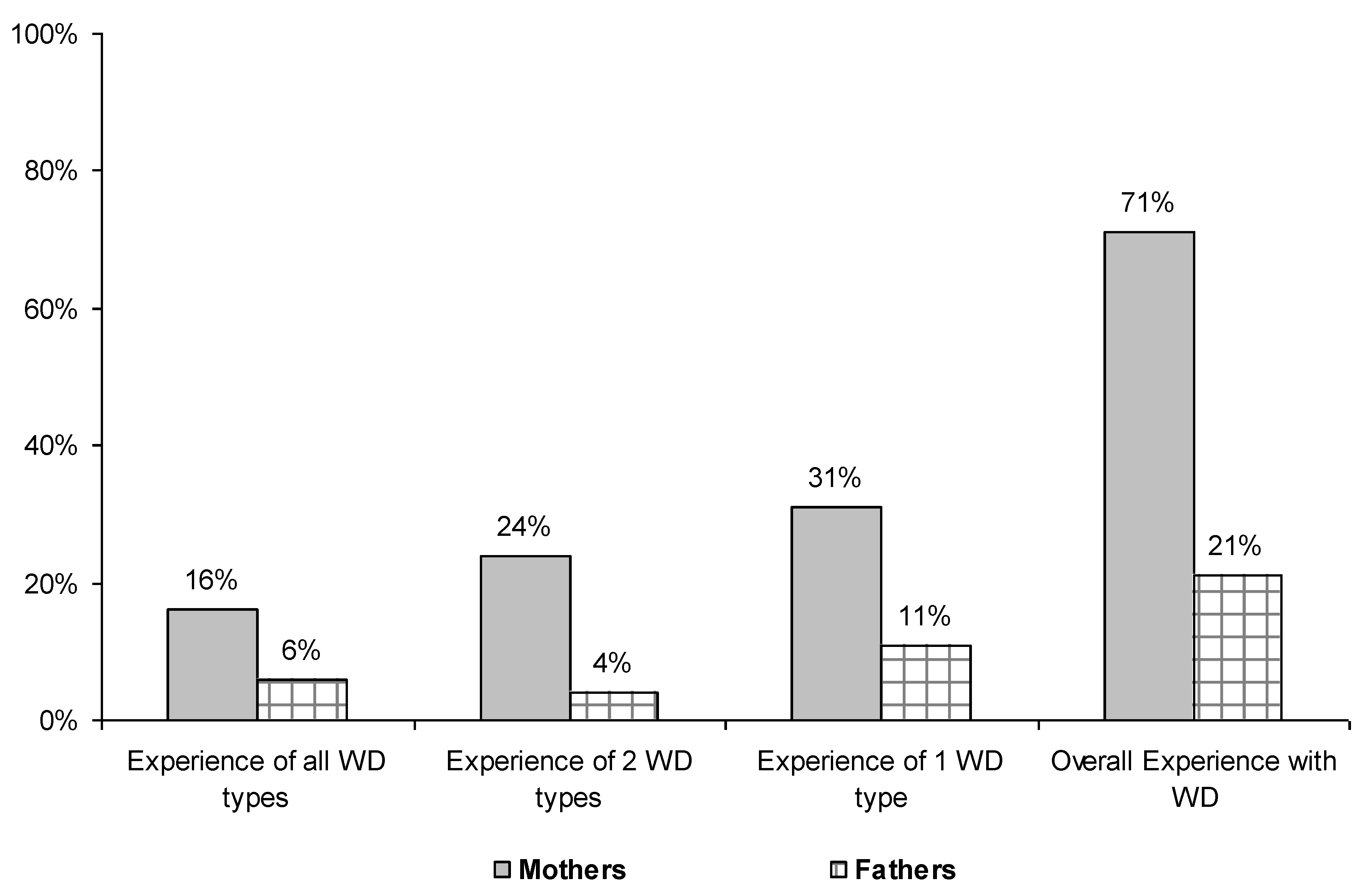
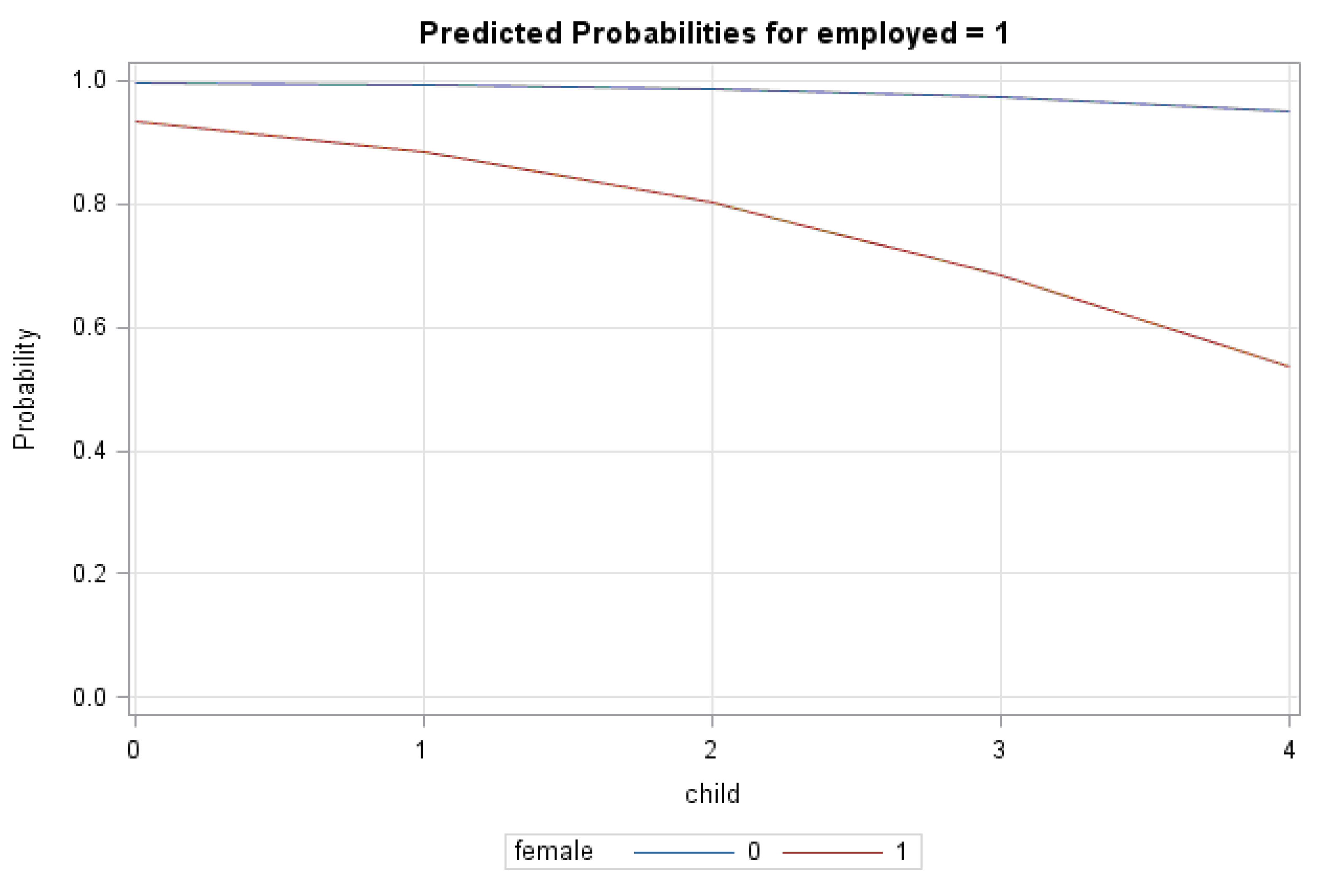
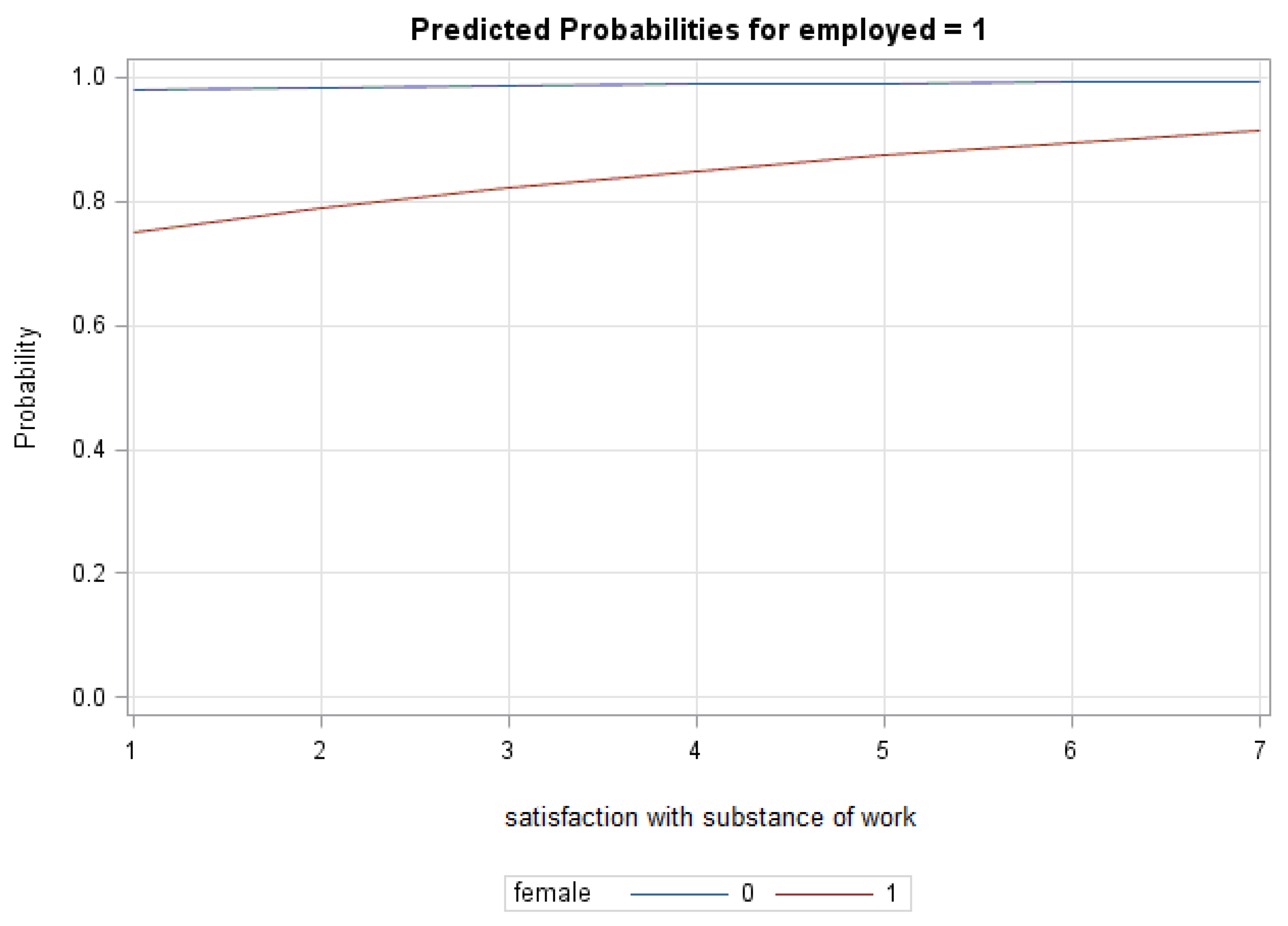
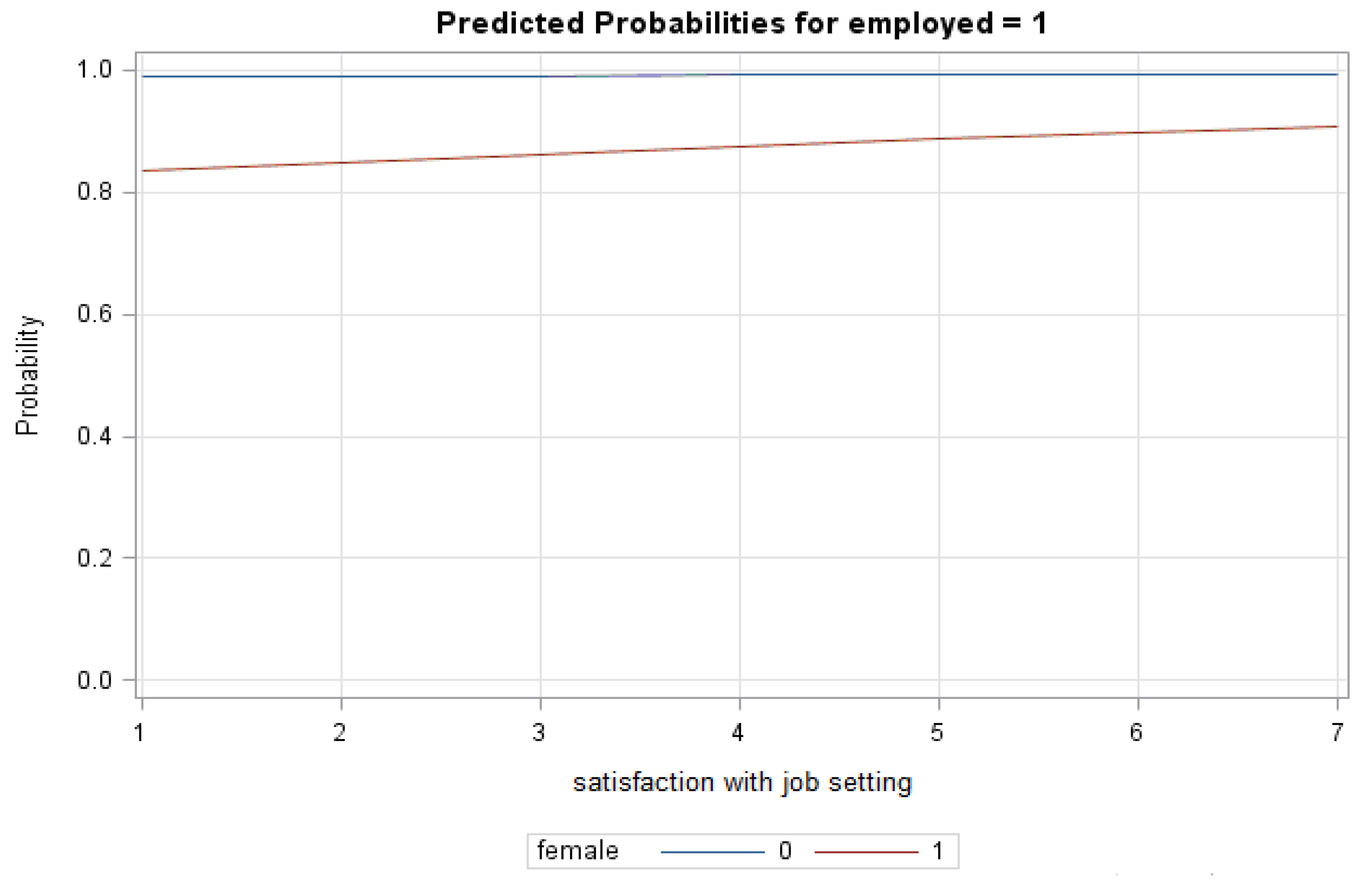
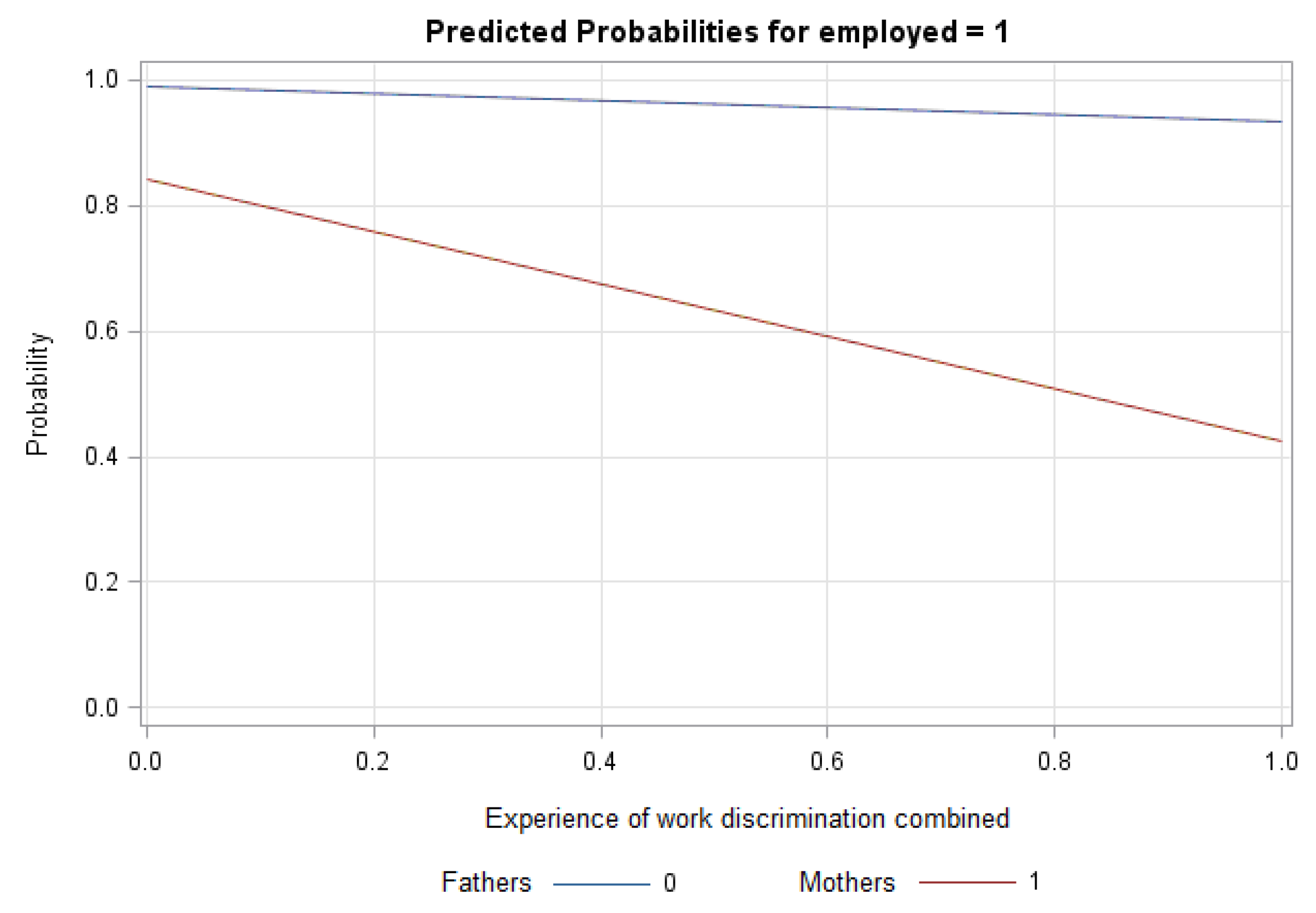
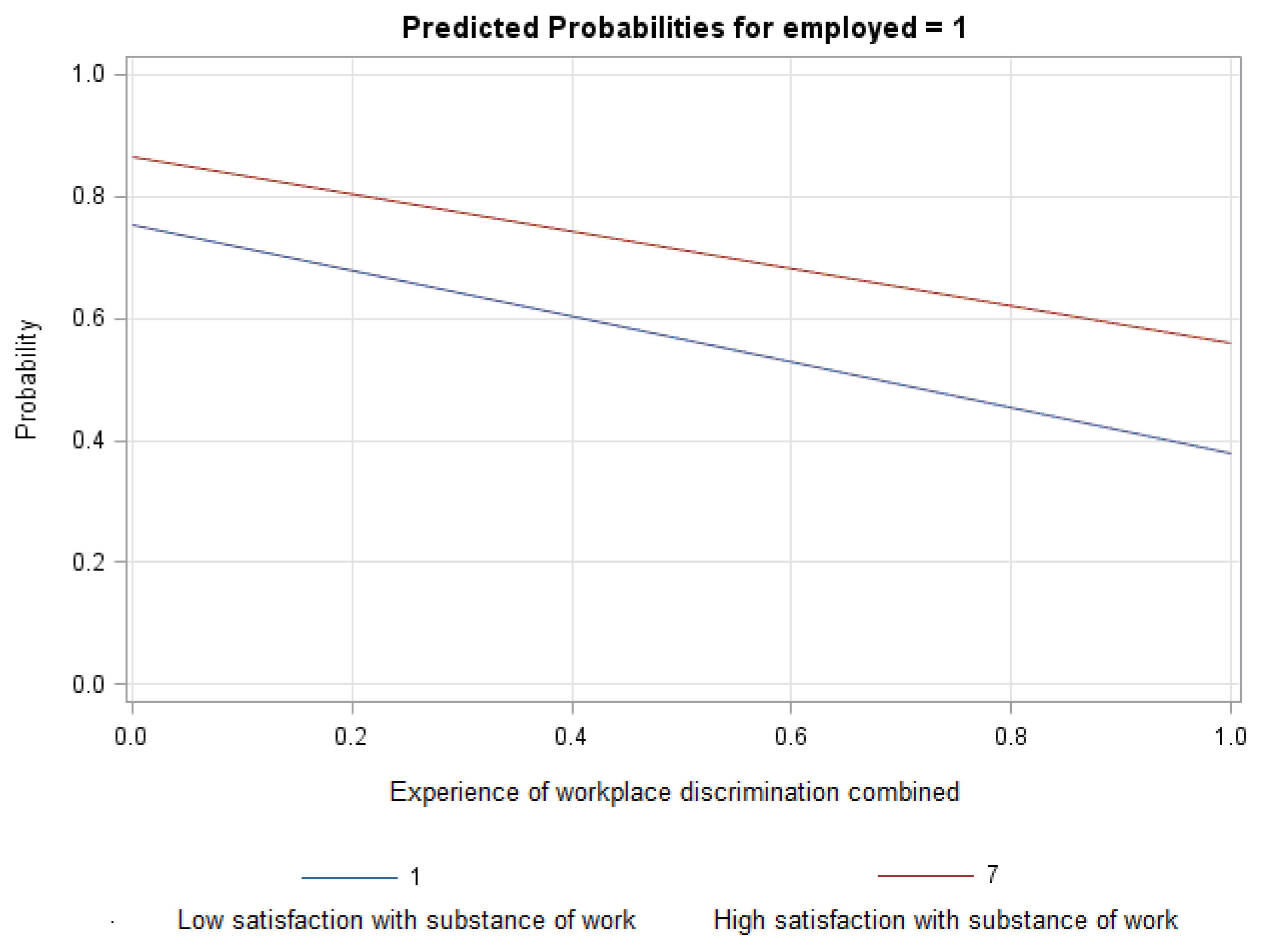
| A | B | C | D | E | F | |||||||
|---|---|---|---|---|---|---|---|---|---|---|---|---|
| Mothers | Non-Mothers | All Women | Fathers | Non-Fathers | All Men | |||||||
| (N = 703) | (N = 645) | (N = 1348) | (N = 883) | (N = 642) | (N = 1525) | |||||||
| Variables | Mean | SD | Mean | SD | Mean | SD | Mean | SD | Mean | SD | Mean | SD |
| Employment Status | ||||||||||||
| Full-time | 0.74 bc | - | 0.96 | - | 0.85 a | - | 0.98 | - | 0.98 | - | 0.98 | - |
| Part-time | 0.26 bc | - | 0.04 | - | 0.15 a | - | 0.02 | - | 0.02 | - | 0.02 | - |
| Practice Setting | ||||||||||||
| Solo | 0.09 | - | 0.06 | - | 0.07 a | - | 0.09 | - | 0.11 | - | 0.10 | - |
| Firms 21–100 Lawyers | 0.29 b | - | 0.23 | - | 0.26 | - | 0.32 | - | 0.29 | - | 0.31 | - |
| Firms >100 Lawyers | 0.19 | - | 0.17 | - | 0.18 | - | 0.22 | - | 0.18 | - | 0.20 | - |
| Public and nonprofit | 0.28 c | - | 0.36 | - | 0.32 a | - | 0.19 | - | 0.23 | - | 0.21 | - |
| Business | 0.16 | - | 0.19 | - | 0.18 | - | 0.19 | - | 0.20 | - | 0.19 | - |
| Structural Work Characteristics | ||||||||||||
| Job Satisfaction with | ||||||||||||
| Substance of work | 5.69 bc | 1.12 | 5.52 | 1.23 | 5.61 a | 1.18 | 5.61 | 1.18 | 5.45 | 1.301 | 5.55 | 1.23 |
| Job setting | 5.53 bc | 1.15 | 5.38 | 1.20 | 5.47 a | 1.18 | 5.48 | 1.15 | 5.34 | 1.144 | 5.42 | 1.15 |
| Power track | 4.78 b | 1.46 | 4.61 | 1.55 | 4.70 | 1.51 | 4.97 | 1.46 | 4.75 | 1.518 | 4.88 | 1.49 |
| Workplace Discrimination | ||||||||||||
| Questioning Commitment | 0.39 c | 0.49 | - | - | 0.39 a | 0.49 | 0.14 | 0.35 | - | - | 0.14 | 0.35 |
| Impact on Performance | 0.31 c | 0.46 | - | - | 0.31 a | 0.46 | 0.04 | 0.20 | - | - | 0.04 | 0.20 |
| “Ideal Worker” Expectations | 0.25 c | 0.43 | - | - | 0.25 a | 0.43 | 0.13 | 0.34 | - | - | 0.13 | 0.34 |
| Personal Background Characteristics | ||||||||||||
| Household Tasks | −1.03 c | 1.96 | −1.18 | 1.64 | −1.11 a | 1.82 | 1.60 | 1.61 | −0.89 | 1.757 | 0.59 | 2.06 |
| No Children | - | - | 0.49 b | - | 0.49 a | 0.50 | - | - | 0.42 | - | 0.42 | 0.49 |
| One Child | 0.47 bc | - | - | - | 0.24 a | 0.43 | 0.33 | 0.47 | - | - | 0.19 | 0.40 |
| Two Children | 0.42 bc | - | - | - | 0.22 a | 0.41 | 0.44 | 0.50 | - | - | 0.26 | 0.44 |
| Three and more | 0.11 bc | - | - | - | 0.06 a | 0.23 | 0.23 | 0.42 | - | - | 0.13 | 0.34 |
| Married | 0.92 b | - | 0.52 | - | 0.73 a | 0.44 | 0.97 | 0.18 | 0.55 | 0.498 | 0.79 | 0.41 |
| Minority | 0.18 bc | - | 0.23 | - | 0.20 a | - | 0.13 | - | 0.21 | - | 0.16 | - |
| Law School Rank | 3.17 bc | 1.08 | 2.99 | 1.11 | 3.08 | 1.10 | 3.14 | 1.07 | 2.98 | 1.102 | 3.09 | 1.08 |
| Model 1 | Model 2 | Model 3 | |
|---|---|---|---|
| Odds | Odds | Odds | |
| Background Characteristics | |||
| Female | 0.041 *** | 0.038 *** | 0.037 *** |
| [0.031, 0.053] | [0.029, 0.049] | [0.028, 0.049] | |
| Nonwhite a | 0.920 | 0.892 | 0.908 |
| [0.744, 1.136] | [0.720, 1.104] | [0.731, 1.128] | |
| Law School Rank | 1.275 *** | 1.328 *** | 1.338 *** |
| [1.203, 1.350] | [1.249, 1.412] | [1.257, 1.424] | |
| Married or cohabitating b | 0.193 *** | 0.206 *** | 0.185 *** |
| [0.123, 0.301] | [0.133, 0.320] | [0.117, 0.294] | |
| Children c | 0.841 ** | 0.853 ** | 0.841 ** |
| [0.757, 0.934] | [0.764, 0.952] | [0.752, 0.940] | |
| Household Tasks d | 1.196 *** | 1.168 *** | 1.178 *** |
| [1.156, 1.237] | [1.127, 1.210] | [1.136, 1.221] | |
| Practice Setting e | |||
| Firm of 21–100 lawyers | - | 2.885 *** | 2.818 *** |
| [2.145, 3.880] | [2.066, 3.844] | ||
| Firm of >100 lawyers | - | 3.080 *** | 3.289 ** |
| [2.218, 4.276] | [2.308, 4.687] | ||
| Non-profit f | - | 4.627 *** | 4.766 *** |
| [3.367, 6.357] | [3.427, 6.630] | ||
| Business | - | 3.379 *** | 3.555 *** |
| [2.436, 4.687] | [2.575, 5.025] | ||
| Workplace | |||
| Job Satisfaction with | |||
| Substance of Work | - | - | 1.166 ** |
| [1.068, 1.274] | |||
| Job Setting | - | - | 1.095 * |
| [1.002, 1.198] | |||
| Power track | - | - | 1.043 |
| [0.971, 1.120] | |||
| Intercept | 4.568 | 3.382 | 1.895 |
| −2 Log L | 5521.62 | 5394.00 | 5320.00 |
| Pseudo Rsquare | 0.71 | 0.73 | 0.74 |
| Mothers | Fathers | Parents | |
|---|---|---|---|
| Model 1 | Model 2 | Model 3 | |
| Odds | Odds | Odds | |
| Mothers 1 | - | - | 0.052 *** |
| [0.039, 0.069] | |||
| Children | 0.841 * | 2.291 ** | 0.899 |
| [0.751, 0.943] | [1.427, 3.678] | [0.803, 1.007] | |
| Household Tasks 2 | 1.186 *** | 1.043ns | 1.172 *** |
| [1.142, 1.231] | [.906, 1.201] | [1.129, 1.217] | |
| Structural Workplace Characteristics: Workplace Discrimination due to child | |||
| Workplace Discrimination (combined) 3 | - | - | 0.140 *** |
| [0.091, 0.216] | |||
| Questioning Commitment | 0.810 * | 0.183 ** | - |
| [0.671, 0.977] | [0.058, 0.577] | ||
| Questioning Performance | 0.361 *** | 0.053 ** | - |
| [0.275, 0.473] | [0.007, 0.412] | ||
| Ideal Worker Expectation | 0.908ns | 0.502ns | - |
| [0.755, 1.092] | [0.202, 1.247] | ||
| Intercept | 0.730 | −0.741 | 2.721 |
| −2 Log L | 3773.28 | 694.00 | 5320.00 |
| Pseudo Rsquare | 0.87 | 0.63 | 0.76 |
© 2017 by the authors. Licensee MDPI, Basel, Switzerland. This article is an open access article distributed under the terms and conditions of the Creative Commons Attribution (CC BY) license (http://creativecommons.org/licenses/by/4.0/).
Share and Cite
Plickert, G.; Sterling, J. Gender Still Matters: Effects of Workplace Discrimination on Employment Schedules of Young Professionals. Laws 2017, 6, 28. https://doi.org/10.3390/laws6040028
Plickert G, Sterling J. Gender Still Matters: Effects of Workplace Discrimination on Employment Schedules of Young Professionals. Laws. 2017; 6(4):28. https://doi.org/10.3390/laws6040028
Chicago/Turabian StylePlickert, Gabriele, and Joyce Sterling. 2017. "Gender Still Matters: Effects of Workplace Discrimination on Employment Schedules of Young Professionals" Laws 6, no. 4: 28. https://doi.org/10.3390/laws6040028
APA StylePlickert, G., & Sterling, J. (2017). Gender Still Matters: Effects of Workplace Discrimination on Employment Schedules of Young Professionals. Laws, 6(4), 28. https://doi.org/10.3390/laws6040028




